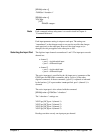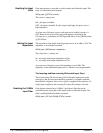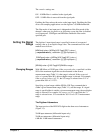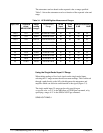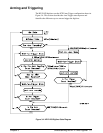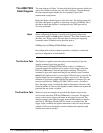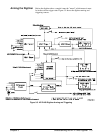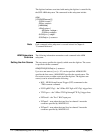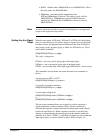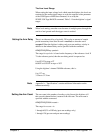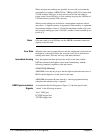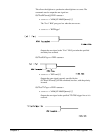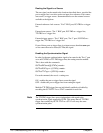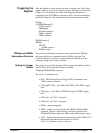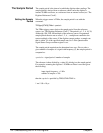
• HOLD - disables either ARM:SOURce1 or ARM:SOURce2. This is
the reset source for ARM:SOURce2.
• IMMediate - arms the digitizer immediately after
INITiate[:IMMediate] is received. This choice is only valid for
ARM:SOURce1. If IMMediate is specified, HOLD must be
specified for ARM:SOURce2. IMMediate is the reset value for
ARM:SOURce1.
Note An active reference oscillator is required for the digitizer to recognize and
accept an arm signal from any source.
Setting the Arm Signal
Slope
When the arm source is INTernal1, INTernal2, or EXTernal1, the digitizer
arms on a specified level of a positive-going or negative-going input signal.
For these sources, the digitizer must be informed of the slope on which to
arm (positive-going, negative-going, or either (for INTernal<n >)). This is
done with the command:
ARM[:STARt]:SLOPe[<
n
>] <
edge
>
The <edge > settings are:
POSitive - arm on a positive-going edge of the input signal.
NEGative - arm on a negative-going edge of the input signal.
EITHer - arm on either edge of the input signal (INTernal<n > sources only).
The command is used with the arm source and arm level commands as
shown:
!set arm source to INT1 or INT2
ARM[:STARt]:SOURce[<
n
>] <
source
>
!set positive or negative transition
ARM[:STARt]:SLOPe[<
n
>] <
edge
>
!set arm input voltage level
ARM[:STARt]:LEVel[<
chan
>]:POSitive <
voltage
>
or
ARM[:STARt]:LEVel[<
chan
>]:NEGative <
voltage
>
The arm slope command allows you to specify a positive transition, a
negative transition, or either transition. When a positive transition is
specified, the digitizer is armed when the increasing signal on the channel
reaches the specified level. When a negative transition is specified, the
digitizer is armed when the decreasing signal on the channel reaches the
specified level. When "EITHer" is specified, the digitizer is armed when the
input signal enters or exits the defined window. Refer to Figure 3-6.
Chapter 3 Understandin
g
the HP E1429 Di
g
itizer 115



